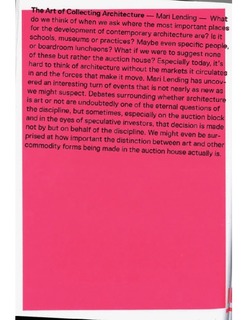| dc.contributor.author | Lending, Mari | |
| dc.date.accessioned | 2018-05-31T07:40:53Z | |
| dc.date.available | 2018-05-31T07:40:53Z | |
| dc.date.created | 2015-08-24T12:38:39Z | |
| dc.date.issued | 2015 | |
| dc.identifier.citation | Volume. 2015, (44), 16-25. | nb_NO |
| dc.identifier.issn | 1574-9401 | |
| dc.identifier.uri | http://hdl.handle.net/11250/2499847 | |
| dc.description.abstract | What do we think of when we ask where the most important places for the development of contemporary architecture is? Is it schools, museums or practices? Maybe even specific people, or boardroom luncheons? What if we were to suggest none of these but rather the auction house? Especially today, it's hard to think of architecture without the markets it circulates in and the forces that make it move. Mari Lending has uncovered an interesting turn of events that is not nearly as new as we might suspect. Debates surrounding whether architecture is art or not are undoubtedly one of the eternal questions of the discipline, but sometimes, especially on the auction block and in the eyes of speculative investors, that decision is made not by but on behalf of the discipline. We might even be surprised at how important the distinction between art and other commodity forms being made in the auction house actually is. | nb_NO |
| dc.language.iso | eng | nb_NO |
| dc.title | The Art of Collecting Architecture | nb_NO |
| dc.title.alternative | The Art of Collecting Architecture | nb_NO |
| dc.type | Journal article | nb_NO |
| dc.description.version | publishedVersion | nb_NO |
| dc.source.pagenumber | 16-25 | nb_NO |
| dc.source.journal | Volume | nb_NO |
| dc.source.issue | 44 | nb_NO |
| dc.identifier.cristin | 1259579 | |
| dc.relation.project | Norges forskningsråd: 231405 | nb_NO |
| cristin.unitcode | 189,4,0,0 | |
| cristin.unitname | Institutt for form, teori og historie | |
| cristin.ispublished | true | |
| cristin.fulltext | original | |
| cristin.qualitycode | 0 | |
